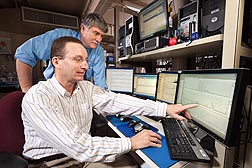Monitoring Best Practices for Food Analysis
The First Step—Monitoring What We Eat
|
|
Nestled in the Maryland suburbs outside northeast Washington, D.C., is arguably the world’s largest and most diversified agricultural research complex—the Henry A. Wallace Beltsville Agricultural Research Center (BARC). Among its 7,000 acres of fields, farmland, and science buildings is the Beltsville Human Nutrition Research Center (BHNRC)—the oldest and most comprehensive of six human nutrition research centers within the Agricultural Research Service. Two new buildings—totaling more than 100,000 square feet of research space—were added to BHNRC in 2003.
“The first human nutrition research conducted by the U.S. Department of Agriculture dates back to the late 1890s,” says Allison Yates, the nutrition center’s former director, “and USDA nutrition research first moved to the Beltsville area in 1941.” Yates is now BARC’s associate director. Nutrition center researchers oversee the national food and nutrient databases and national dietary-intake survey. These products are the tools used by scientists to examine the influence of dietary interventions on human health. Besides nutrition monitoring, the nutrition center’s research program also includes investigating the role of food nutrients at the cellular level as well as in animal models and in human studies.
One of the nutrition center’s five laboratories is the Food Composition and Methods Development Laboratory, where researchers ensure that good food-analysis methods exist. “You can’t monitor people’s nutrient intakes from their diets without knowing what’s in the foods they eat,” says Yates.
Headed by chemist James Harnly, the laboratory’s researchers design, develop, and improve analytical methods for measuring nutritional components in the food supply. These include nutrients and their secondary metabolites—substances produced by metabolism—and other bioactive food components. The analytical methods help food manufacturers and researchers provide values to the USDA food-composition database that consumers can trust.
The scientists then transfer these technologies to the private, public, and academic sectors. “We transfer our technology and data to users through peer-reviewed publications, official methods, scientific meetings, and scientific contracts,” says Harnly.
The most recent addition to the laboratory’s capabilities is a high-resolution mass spectrometer (HRMS). Harnly’s group is using new spectrometry methods to discover compounds in foods that have never before been documented.
The researchers produce an extraction from a food or supplement sample with which to conduct different types of analyses. They can look at the entire extraction—with no separation—to create a “spectral fingerprint.” Using pattern-recognition methods, the fingerprints can be “matched” with other standard profiles, similar to how crime investigators use a fingerprint database to make matches. The components of the extractions can also be separated by chromatography and then identified or detected individually, providing an understanding of all the products of metabolism.
Identifying botanical material in dietary supplements is also a concern. For example, HRMS is useful for identifying potential adulteration of dietary supplement ingredients.
|
|
Other BHNRC studies are showing that HRMS fingerprinting, when combined with chemical and statistical pattern methods called ANOVA-Principal Component Analysis, can clearly establish chemical differences between food samples in terms of growing year and harvest time (early, mid, and late season).
With proven food-analysis methods as a foundation for nutrition monitoring, other BHNRC researchers improve the design and validate the accuracy of dietary-survey instruments. “Scientifically analyzing and tracking the nutritional components within the U.S. food supply provides a foundation for other BHNRC researchers who monitor the food intakes of individuals and analyze the population’s overall eating patterns nationwide,” says Yates.
Better Analysis Methods for Vitamin D
Accurate data on the amount of vitamins and minerals in the U.S. food supply is critical to accurately assessing the intakes of these nutrients by the U.S. population.
BHNRC chemist Craig Byrdwell has pioneered new, highly precise methods for analyzing vitamin D in foods and dietary supplements. Byrdwell authored a book chapter describing his vitamin D analysis methods, which appears in “Extreme Chromatography.” Byrdwell is also a co-editor of the book, which was published in May 2011.
“There are many ways in which multiple instruments that measure molecules can be used in parallel to provide much more information about food samples than single instruments used alone,” says Byrdwell. These molecular mass-measuring instruments are called “mass spectrometers.” One of Byrdwell’s techniques is “dual-parallel mass spectrometry,” in which two mass spectrometers are used in parallel. Another technique is “triple-parallel mass spectrometry” in which three mass spectrometers, operating in different modes, are used in parallel.
Byrdwell’s experiments have also shown that two systems for separating molecules (liquid chromatographs) can be used in combination to analyze complex food samples for vitamin D and its metabolites.
The amount of vitamin D permitted to be added in fortified American foods is regulated by the U.S. Food and Drug Administration (FDA). For example, orange juice and milk contain very little natural vitamin D, so orange juice is often fortified, and milk is almost always fortified, with vitamin D3. Milk contains calcium, but calcium absorption by the body requires the presence of vitamin D. That is the main reason milk was originally chosen as a main food to be fortified with vitamin D, according to Yates. The goal was to prevent rickets—a disorder caused by a lack of vitamin D, calcium, or phosphate that leads to soft, weak bones in children.
“We can’t evaluate vitamin D intake unless we know how much people are getting from food and supplements,” says Yates. “And we must attempt to estimate sun exposure.” Vitamin D3 is the form of vitamin D that humans make by the action of sunlight on skin.
In May 2011, Byrdwell and colleagues published a study on the use of liquid chromatography, with ultraviolet and dual-parallel mass spectrometry, to analyze the amount of vitamin D3 in samples of retail vitamin D-fortified orange juice.
Currently, FDA has approved vitamin D fortification of fruit juices at levels not to exceed 100 international units (IU)—2.5 micrograms—for about 1 cup of 100 percent fruit juice. (FDA recognizes either vitamin D2 or vitamin D3 as meeting the recommendation/requirement for vitamin D.) Vitamin D-fortified juices must also be fortified with at least one-third of the reference daily value of calcium for balance.
Because there is an acceptable range of vitamin D fortification, there is a need for analysis to determine the initial levels of vitamin D in a food or drink before fortification and the actual amount of the vitamin added to the products.
Byrdwell and colleagues analyzed 47 commercially available fortified orange juice samples to determine their vitamin D3 content. “We sampled 12 cities and 4 brands per city,” says BHNRC nutritionist Jacob Exler, a coauthor of the study. (The project is part of the article on "National Food and Nutrient Analysis Program" in this issue.)
Nearly all samples were found by two different analytical methods to contain more vitamin D than the amount listed on the label.
Byrdwell estimates that more vitamin D is put into the juice initially than the label states to make up for potential declining levels during storage, so that the product will contain at least the amount stated on the label.
The study showed that nearly all commercially available orange juice brands tested contained levels of vitamin D3 above the FDA-stipulated amount. The 2011 published study appears in the Journal of Food Composition and Analysis.
In 2007, a BHNRC team also analyzed 5 types of fluid milk collected from 24 sample locations nationwide for vitamin D3 levels: whole, skim, 1 percent fat (white and chocolate), and 2 percent fat. The team used HPLC with ultraviolet spectroscopic detection—a method the team has specifically validated for analyzing vitamin D content in milk.
Since fortification is optional, FDA stipulates thatif a manufacturer fortifies milk with vitamin D, the milk must have a vitamin D content of 400 IU (10 micrograms) per quart. Because FDA allows a 50-percent overage, the acceptable range of vitamin D-milk fortification is actually 400 IU to 600 IU (10 to 15 micrograms) per quart.
For people aged 4 through 70 years and older, an 8-ounce glass of milk fortified with 150 IU of vitamin D would provide more than the label’s 25 percent daily value (about 37.5 percent).
“This tolerance means the actual vitamin D content of an individual carton of milk can vary widely from the label value, and that’s what we found in the milk samples,” says Byrdwell. “We did not find that wide a range of variability among the orange juice samples.”
Of the 120 milk samples procured in 2007, 16 percent had less than the stipulated 400 IU of vitamin D3 per quart; 77 percent had vitamin D3 between 400 IU and 600 IU; and 7 percent had more than 600 IU per quart (which is greater than the FDA-allowed overage). The 2010 published study appears in the Journal of Dairy Science.
“Fortified milk is an important source of vitamin D for many North Americans, and current and accurate data is important to the assessment of vitamin D intake throughout the population,” says Exler. Manufacturers of 2 percent milk enjoy the highest sales figures of all fluid milks, according to Exler. More than 80 percent of the 2 percent milk samples collected in 2007 had at least the required amount of vitamin D3 (400 IU per quart).
Results of the orange juice and milk analyses have been used to update food-composition data in the USDA National Nutrient Database for Standard Reference, the primary source of nutrient information used when estimating the nutrient intake of the U.S. population. Read more about the national nutrient database in part two of this series, in the article "Monitoring Food-Supply Nutrients: The Second Step—Conservators of the National Nutrient Database" in this issue.
These and earlier studies underscore the importance of accurate nutrient analysis of everyday foods to nationwide nutrition monitoring efforts.—By Rosalie Marion Bliss, Agricultural Research Service Information Staff.
This research is part of Human Nutrition, an ARS national program (#107) described at www.nps.ars.usda.gov.
James M. Harnly is with the USDA-ARS Food Composition and Methods Development Laboratory, 10300 Baltimore Ave., Bldg. 161, Beltsville, MD 20705-2350; (301) 504-8569.
Until recently, highly accurate analysis methods for tracking the vitamin D content in foods were not available. (See section on “Better Analysis Methods for Vitamin D,” above.) Yet very few foods in nature contain vitamin D—so knowing how much vitamin D is in foods and supplements is important for monitoring the population’s overall intake.
Vitamin D helps the body use calcium and phosphorus to build and maintain strong bones and teeth. Vitamin D can be formed in human skin by sunlight. But when sun exposure is limited, dietary sources are needed. Vitamin D is added to some foods (called “fortification”) and is available in some dietary supplements.
New and relevant scientific research prompted governments to reevaluate the adequate intakes of vitamin D and calcium. As a result, new vitamin D Dietary Reference Intakes were issued in November 2010 by the U.S. Institute of Medicine—part of the National Academies.
The new science-based vitamin D analysis methods from the Agricultural Research Service and analytical values for foods and supplements provided previously unavailable information to those who evaluate the human requirements for vitamin D and to those who monitor vitamin D levels via population studies.
"Monitoring Best Practices for Food Analysis: The First Step—Monitoring What We Eat" was published in the March 2012 issue of Agricultural Research magazine.










